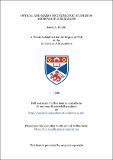Files in this item
Optical and mass spectrometric studies of microwave discharges
Item metadata
| dc.contributor.advisor | Maitland, Arthur | |
| dc.contributor.author | Hewitt, Janet A. | |
| dc.coverage.spatial | 203 p. | en_US |
| dc.date.accessioned | 2018-06-06T10:00:20Z | |
| dc.date.available | 2018-06-06T10:00:20Z | |
| dc.date.issued | 1986-07 | |
| dc.identifier.uri | https://hdl.handle.net/10023/13754 | |
| dc.description.abstract | The structure, operation and performance characteristics of the TR cell and its role in microwave duplexing in a radar system are discussed. Theory of the microwave discharge is discussed, and the mathematics of microwave transmission along a waveguide examined. Two computer models are established; one to model the transfer of heat from the microwave discharge in the cell to the cell window, and one to model the operation of the TR cell, in terms of the reaction kinetics of the gases within. The results of both models are compared with experimental observations. Finally, the gas in the cell is analysed throughout the manufacturing procedure of the cell and during its operation. Study of the mathematics of microwave transmission along a waveguide leads to expressions for the conductivity, and reflection and transmission coefficients for an ionized gas, resulting in calculations of the electron density in the ionized gas as a function of input power. A computer program to model the heat transfer from the microwave discharge in the TR cell to the cell window has been written. Good agreement with experimental results has been obtained. The temperatures at selected points on the TR cell window, frame and flange are calculated, using the finite difference method. The power incident on the window is input to the program together with the window dimensions and materials selected. The output from the program is in the form of temperatures at selected points across the TR cell window, frame and flange. The temperature at which a window is likely to fail is estimated from the results of the program. Three different techniques are used in the analysis of the gas in the TR cell during its manufacture and operation. They are the study of relative changes in peak heights in the microwave-excited optical emission spectrum of the gas, using an optical spectrum analyser with a recording facility, measurement of the performance of the cell when subject to high power microwave pulses and finally, mass spectrometry of the gases in the cell. Several batches of cells were studied. Using the results from these different analytical techniques, the manufacturing procedure and the operation of the cell are discussed. The batch of cells analysed using mass spectrometry contained traces of oxides of carbon and nitrogen, which were shown to have a negative influence on the performance of the cells. Finally, a computer model of the operation of the TR cell is established. The reaction rates and cross sections of the species likely to be present are calculated from the available literature. The model predicts the number densities of the species present as a function of the operating time of the cell and is used to predict the useful lifetime of the cell. The partial success of the model is due in part to the scarcity of reaction rate data for the microwave discharge. | en_US |
| dc.language.iso | en | en_US |
| dc.publisher | University of St Andrews | |
| dc.subject.lcc | TK7871.3H3 | |
| dc.subject.lcsh | Lasers | |
| dc.title | Optical and mass spectrometric studies of microwave discharges | en_US |
| dc.type | Thesis | en_US |
| dc.type.qualificationlevel | Doctoral | en_US |
| dc.type.qualificationname | PhD Doctor of Philosophy | en_US |
| dc.publisher.institution | The University of St Andrews | en_US |
This item appears in the following Collection(s)
Items in the St Andrews Research Repository are protected by copyright, with all rights reserved, unless otherwise indicated.

